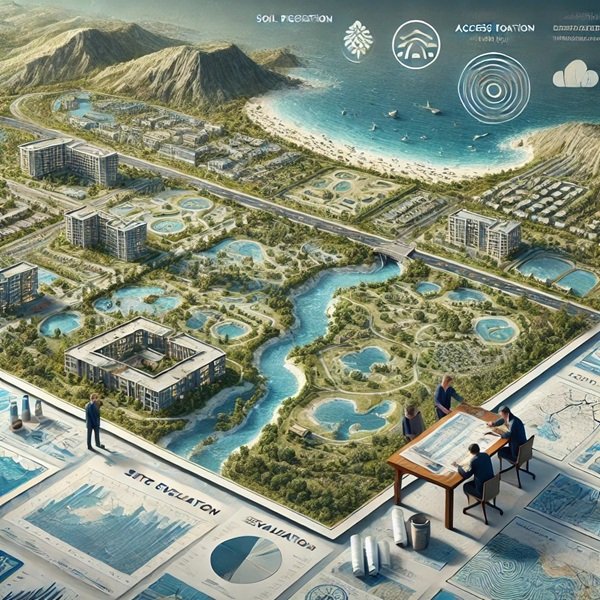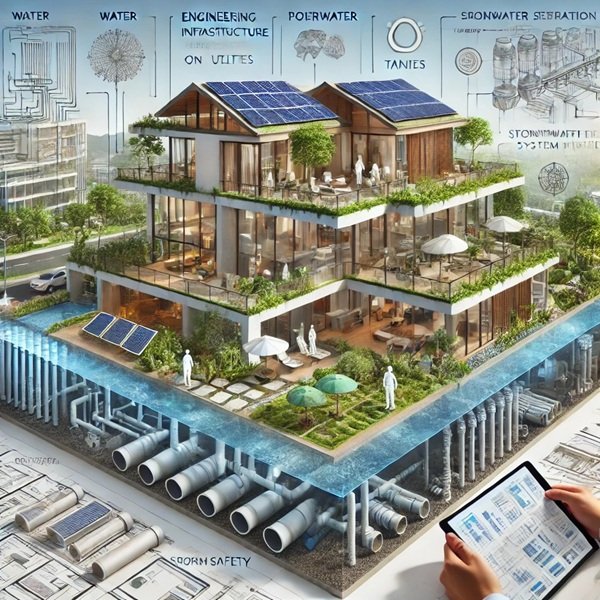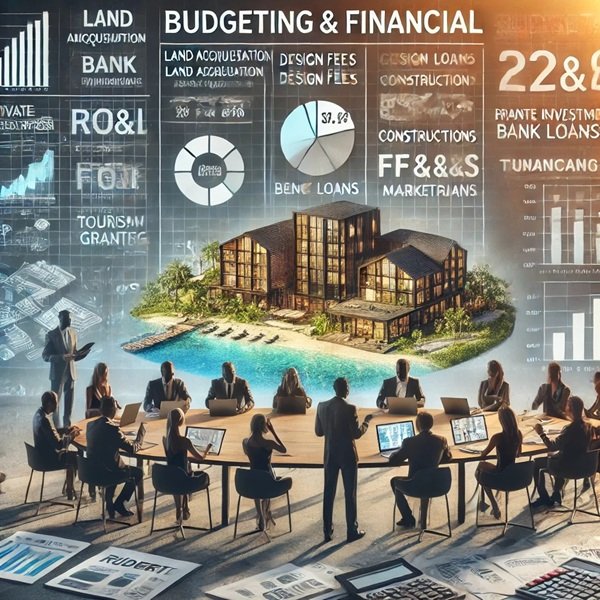How to Plan a Resort Construction Project | Step-by-Step Guide
Building a resort is not just about pouring concrete near a beach and adding palm trees. It’s a multi-phase journey that blends visionary design, strategic planning, environmental stewardship, and guest-centred thinking. Whether it’s a luxury beachfront escape, a wellness retreat in the mountains, or a themed family resort, the planning phase is the foundation of its success.
In this comprehensive guide, we’ll walk you through each major stage of a resort construction project, from site selection to grand opening—highlighting the essentials, challenges, and strategies involved.
1. Vision and Concept Development
Every successful resort starts with a clear vision.
Define the Experience
Ask: What type of resort are you creating?
-
Luxury resort
-
Eco-resort
-
Family adventure resort
-
Wellness and spa retreat
-
Business or MICE resort (Meetings, Incentives, Conferences, Exhibitions)

Your resort’s core concept will influence its layout, style, services, and even materials. For instance, an eco-resort may focus on locally sourced materials, minimal land disturbance, and off-grid energy systems.
Market Research
Conduct feasibility studies:
-
Target audience analysis (domestic or international travellers?)
-
Demand forecast (seasonality, length of stay, spending patterns)
-
Competitor landscape
-
Pricing strategy
This phase sets the stage for creating a resort that fits its market while offering something uniquely compelling.
2. Site Selection and Land Evaluation
Location is everything. The right site can make or break a resort.
Factors to Consider:
-
Accessibility (by car, plane, or ferry)
-
Topography (flat land, slopes, sea cliffs, etc.)
-
Climate and weather patterns
-
Scenic value (beaches, forests, mountains, etc.)
-
Environmental sensitivity (wetlands, protected habitats)
-
Local community and planning regulations

Site Analysis
-
Soil testing and geotechnical studies
-
Flood risk assessments
-
Viewshed and sunlight analysis
-
Water availability and drainage conditions
Regulatory Due Diligence
Check local zoning, land-use plans, and statutory protections like:
-
Coastal protection zones
-
National parks or heritage overlays
-
Infrastructure limitations (power, roads, sewer)
Engage with local authorities and consultants early—a proactive approach can prevent years of delay later.
3. Master Planning and Resort Layout
Once the land is secured, it’s time to shape the overall resort masterplan.
Key Principles:
-
Zoning: Divide the land into guest areas (accommodation, amenities), staff quarters, back-of-house, recreation areas, and open space.
-
Circulation: Plan access roads, pedestrian pathways, buggy routes, and service entries with clear hierarchies.
-
View and Privacy: Ensure premium views for key units while preserving privacy and quiet zones.
-
Phasing: Consider whether the resort will be built in phases. Design the site to accommodate future expansion.

Include:
-
Reception/lobby area
-
Guest accommodations (villas, rooms, suites)
-
Dining areas (restaurants, cafés, bars)
-
Pools and recreational facilities
-
Spa or wellness centres
-
Event spaces or meeting rooms
-
Parking and staff facilities
-
Utility/service areas (laundry, kitchens, waste, storage)
An effective masterplan is both functional and guest-focused, while respecting the site’s natural character.
4. Architecture and Theming
This stage gives the resort its personality.
Design Philosophy:
-
Should the design be minimalist, tropical, vernacular, or themed?
-
Does the architecture connect with local traditions or use modern aesthetics?
-
What materials are appropriate: timber, stone, concrete, bamboo?

Guest Experience through Design:
-
Create immersive first impressions (entrance design, lobby experience)
-
Plan open-air layouts for warm climates
-
Prioritise natural ventilation and light
-
Integrate water features, greenery, and transitional indoor-outdoor spaces
-
Incorporate sensory elements (lighting, textures, scents)
Theming and Branding:
-
Theme can shape not just decor, but staff uniforms, menu designs, and guest activities.
-
Resorts that create an emotional or narrative experience (e.g., jungle lodge, Arabian nights, barefoot luxury) enjoy stronger brand loyalty.
5. Engineering, Infrastructure and Utilities
Before you can build, you must plan for the invisible infrastructure that keeps a resort running.
Key Systems:
-
Water supply and purification
-
Electricity (grid or renewable)
-
Wastewater treatment
-
Stormwater drainage
-
Solid waste management
-
Fire safety systems
-
Internet and telecom

Sustainable resorts often rely on:
-
Solar panels and battery storage
-
Rainwater harvesting
-
On-site biofiltration gardens
-
Eco-friendly waste treatment (composting, biogas)
Engineering design must be integrated with architecture and masterplanning from the outset to avoid rework.
6. Environmental and Cultural Impact Assessment
A good resort is a steward of its landscape, not a destroyer.
Key Impact Areas:
-
Biodiversity and habitat loss
-
Coastal erosion and sediment runoff
-
Pollution (during and post-construction)
-
Noise and light pollution
-
Displacement of communities or heritage values

Mitigation Strategies:
-
Retain existing trees and topography where possible
-
Use permeable surfaces and bioswales
-
Set back from coastlines and rivers
-
Design lighting that avoids skyglow
-
Engage local artisans and culture bearers
Environmental reports (like an Environmental Impact Assessment, or EIA) may be mandatory depending on the scale and location.
7. Legal Approvals and Compliance
Each country or region will have different regulatory frameworks, but most will require:
-
Planning permission
-
Environmental permits
-
Heritage approvals
-
Fire safety certification
-
Building control approval
-
Business registration and tourism licensing

Additional Stakeholder Engagement:
-
Local communities
-
Indigenous groups
-
Environmental NGOs
-
Tourism boards
-
Infrastructure providers
Starting legal approvals early can avoid project-stalling objections later on.
8. Budgeting and Financial Planning
A resort is a major investment with many cost centres.
Typical Budget Categories:
-
Land acquisition
-
Design and consultancy fees
-
Approvals and legal costs
-
Site preparation and infrastructure
-
Construction
-
FF&E (furniture, fittings, and equipment)
-
Landscaping
-
Marketing and branding
-
Operational startup costs

Financing Options:
-
Developer equity
-
Private investment
-
Bank loans
-
Joint ventures
-
Government incentives or tourism grants
A sound business plan and ROI model is critical to secure financing.
9. Construction Phase
With plans and permissions in place, construction begins.
Key Construction Phases:
-
Site clearance and levelling
-
Foundations and utilities installation
-
Superstructure and roofing
-
MEP works (Mechanical, Electrical, Plumbing)
-
Interior fit-out and landscaping
-
Snagging and commissioning
Construction Best Practices:
-
Use local contractors and labour where possible
-
Implement strong project management and scheduling tools
-
Monitor cost, time, and quality continuously
-
Address safety and environmental compliance on-site
-
Ensure robust supply chain management
Consider adopting modular or prefabricated construction to speed up build time and reduce waste.
10. Interior Design and Guest Touchpoints
This is where your resort comes alive.
Interior Elements:
-
Theme-based interiors that tell a story
-
Durable yet luxurious materials
-
Smart tech integration (smart lighting, contactless keys)
-
Multi-sensory design: light, sound, texture, aroma
-
Locally crafted décor to add authenticity
Think about guest flow: from check-in to room entry, every step should feel seamless and delightful.
11. Landscaping and Outdoor Experience
Outdoor spaces are as important as buildings.
Landscape Design Goals:
-
Blend built form with natural surroundings
-
Use native, low-maintenance plant species
-
Provide shade, seating, and photo-worthy views
-
Integrate pools, lagoons, gardens, and walking trails
-
Design for both daytime and nighttime ambience
A well-designed landscape adds value by offering quiet zones, recreation areas, and Instagrammable moments.
12. Staffing, Training and Operational Setup
As the resort nears completion, you need to build your team.
Roles to Recruit:
-
General Manager
-
Guest Services
-
Housekeeping and Maintenance
-
Chefs and F&B staff
-
Recreation and spa teams
-
Administrative and finance roles
Setup Essentials:
-
HR policies and staff housing
-
Standard operating procedures (SOPs)
-
Software for bookings, housekeeping, POS, etc.
-
Safety protocols and guest feedback systems
A resort is only as good as its team and service culture. Training should begin well before opening day.
13. Pre-Opening Marketing and Launch Strategy
Marketing Must-Haves:
-
Professional branding and logo
-
High-quality website and booking system
-
Drone videos and photography
-
Social media and travel influencer campaigns
-
Partnerships with travel agents and OTAs (Online Travel Agencies)
Soft Launch vs Grand Opening:
-
Many resorts start with a soft launch to test operations with limited guests.
-
The grand opening should be a press-worthy event that drives awareness and buzz.
Final Thoughts: Building More Than a Resort
A resort is more than a business. It’s a living ecosystem, a guest experience, and a reflection of place.
By carefully planning every phase—from site selection to interior design—you’re not just building a resort; you’re crafting a destination.
In the era of sustainable travel and experience-driven tourism, thoughtful planning is the competitive edge that separates successful resorts from those that struggle to survive.
1 thought on “Resort Construction Project Plan: A Complete Guide from Vision to Reality”